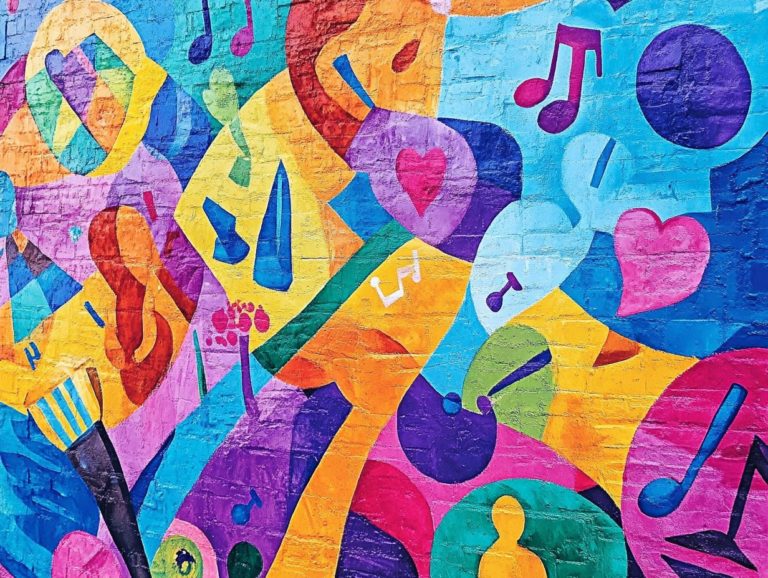the art of conversation: cultural differences explained
Conversations can be quite complex, especially when cultural differences come into play. Understanding how various cultures communicate through language, tone, and ways we communicate without words, like gestures or facial expressions can bridge gaps and foster deeper connections.
This article explores the nuances of verbal and nonverbal communication. It emphasizes the distinctions between direct and indirect styles, the significance of body language, and the importance of culturally sensitive topics.
With practical tips for navigating these diverse interactions, you’ll be better equipped to engage in meaningful dialogues across cultures.
Embark on this journey to uncover the rich tapestry of conversational styles!
Contents
- Key Takeaways:
- Cultural Differences in Conversation
- Verbal Communication
- Unlocking the Power of Nonverbal Communication
- Cultural Norms and Taboos
- Tips for Navigating Conversations with Different Cultures
- Frequently Asked Questions
- What is the art of conversation?
- How do cultural differences impact conversations?
- What are some common cultural differences that can affect conversations?
- How can one overcome cultural differences in conversations?
- Is it appropriate to discuss sensitive topics in cross-cultural conversations?
- How can cultural differences enrich conversations?
Key Takeaways:

Understanding different communication styles is crucial for avoiding misunderstandings and building stronger relationships. Verbal communication, including language and tone, significantly impacts the effectiveness of conversations across cultures. Nonverbal communication, such as body language and gestures, also plays a vital role in cross-cultural conversations and should be adapted accordingly.
Cultural Differences in Conversation
Cultural differences influence how you engage in conversation, shaping your communication style and the emotional bonds you create with others. Recognizing these cultural nuances is essential for fostering meaningful dialogues that honor unspoken rules and encourage social engagement across diverse societies.
This awareness enhances the flow of your conversations and cultivates mutual respect and empathy in your interactions. These elements are vital for effective communication in our increasingly multicultural world.
Understanding Communication Styles
Understanding communication styles is essential for fostering effective conversations, especially when navigating cultural differences.
Direct communication often prioritizes clarity and straightforwardness, making it easier to express thoughts without ambiguity. However, this may not resonate with those who favor indirect communication, where context and nuance are key.
Such differences can lead to misunderstandings. What seems like a simple statement to you might come across as abrupt or rude to someone else.
By honing your emotional intelligence and adapting to various communication styles, you can bridge these gaps. This results in smoother interactions and richer relationships. Recognizing and respecting these diverse approaches will enhance your overall communication skills.
Verbal Communication
Verbal communication involves many elements, including intonation, linguistic style, and speech behavior. Each is crucial for enhancing the quality of your conversations and engaging your audience effectively.
Language and Tone
The language and tone you choose shape the emotional connection you establish with others and the overall effectiveness of your communication.
By selecting your words carefully, you not only convey your messages clearly but also foster respect and understanding. The right tone infuses warmth and empathy into your exchanges, making others feel valued and engaged.
Finding the right speed in your speech helps maintain attention and encourages meaningful dialogue. Effective communication thrives on these dynamics, enhancing interpersonal attunement and leading to smoother interactions and deeper connections.
By being mindful of these elements, you can create an atmosphere where everyone feels comfortable expressing themselves.
Are you ready to enhance your conversations? Start applying these tips today!
Direct vs. Indirect Communication

Direct and indirect communication styles reveal deeper cultural differences, leading to various interpretations and misunderstandings during conversations.
These contrasting approaches shape how you express thoughts and feelings. They influence everything from workplace dynamics to personal relationships.
In cultures that value directness, clear and concise language promotes transparency and quick understanding. In contrast, indirect communicators lean towards harmony and context, often relying on subtle cues or implications, which can result in misinterpretations.
For example, while you might see a straightforward request as effective, someone else could perceive it as aggressive or impolite. This divergence complicates dialogue, creating anxiety. You might find yourself second-guessing your responses, worried about misreading the intention behind the words.
Grasping these dynamics can transform your conversations!
Unlocking the Power of Nonverbal Communication
Nonverbal communication, which includes body language and gestures, is a vital aspect of social interaction.
It conveys meanings that go beyond mere words and reveals emotional intelligence.
Body Language and Gestures
Body language and gestures are crucial nonverbal cues. They can either enhance or hinder emotional connections during conversations.
These physical expressions often convey more about your feelings and intentions than words ever could.
For example, crossed arms might signal defensiveness, while open palms project receptiveness and honesty. A simple nod or a warm smile can foster understanding and rapport, leading to more positive interactions.
Conversely, a lack of eye contact can indicate disinterest or discomfort, dramatically shifting the dynamics of social engagement.
By recognizing these nonverbal signals, you can navigate conversations with greater sensitivity, paving the way for richer and more meaningful exchanges.
Cultural Norms and Taboos
Cultural norms and taboos play a crucial role in shaping the topics you engage in. They guide your understanding of respectful behavior across different cultural contexts.
This awareness fosters emotional connections and helps you navigate the delicate balance of social distance, ensuring that your interactions are both meaningful and considerate.
Topics to Avoid
Understanding which topics to avoid is essential for maintaining respectful behavior and fostering emotional connections across cultural differences.
Navigating sensitive subjects like religion, politics, and personal relationships can often lead to discomfort or misunderstandings among individuals from diverse backgrounds.
For instance, in many cultures, discussing money is deeply personal, while in others, it s an open topic.
Recognizing and respecting these boundaries showcases your emotional intelligence and helps create a more positive atmosphere, allowing conversations to flow more freely.
By steering clear of potentially contentious topics and focusing on shared interests, you can build stronger connections and ensure that everyone feels valued and understood. This approach enhances the overall dialogue experience, making interactions richer and more meaningful.
Respectful Behavior

Demonstrating respectful behavior is crucial for engaging in meaningful conversations and fostering emotional connections, especially in multicultural settings.
Such interactions require you to actively listen, showing genuine interest in the perspectives of others.
By practicing empathy, you can connect on a deeper level, creating an atmosphere where every voice is valued.
This approach not only enhances understanding but also encourages a richer exchange of ideas, allowing everyone to feel heard and acknowledged.
When you embody these traits, others are likely to view you as more trustworthy and approachable, enhancing your social engagement.
As you cultivate respect, emotional bonds strengthen, leading to more cohesive and harmonious dialogue an essential skill for navigating diverse conversations.
Start practicing these tips today to enhance your conversations and build lasting connections!
Navigating conversations across different cultures demands good communication skills, including active listening and an understanding of diverse emotional intelligence.
This approach ensures you convey your message effectively while fostering genuine connections that transcend cultural boundaries.
Active Listening and Asking Questions
Active listening and asking insightful questions are essential skills for engaging meaningfully with others and cultivating emotional connections.
Employing these techniques enhances understanding and fosters a supportive environment where individuals feel genuinely valued and heard.
Listening attentively encourages the speaker to express their thoughts and feelings more openly, deepening the bond between you. This kind of engagement turns a simple chat into a rich conversation, allowing for deeper comprehension and connection.
Recognizing the significance of these methods can significantly enhance interpersonal dynamics, leading to more productive discussions and enriched relationships.
Adapting to Different Communication Styles
Adapting to different communication styles is vital for engaging in meaningful conversations, especially when cultural differences come into play. Understanding different cultural habits can enhance your interactions; it s not just about the words exchanged, but also the emotions and intentions that accompany them.
By sharpening your emotional intelligence, you can better recognize and respond to unspoken cues that often determine the success of cross-cultural exchanges. Active listening and keenly observing non-verbal signals allow you to gauge the comfort levels of others, paving the way for more inclusive dialogues.
Staying flexible and open-minded in diverse environments enables you to adjust your communication tactics as needed and cultivate stronger, more respectful relationships.
Frequently Asked Questions
-
What is the art of conversation?
The art of conversation is the ability to engage in meaningful discussions with others. It involves actively listening, responding appropriately, and respecting cultural differences.
-
How do cultural differences impact conversations?
Cultural differences can impact conversations in various ways, such as language barriers, different communication styles, and varying social norms, affecting the flow and understanding of the conversation.
-
What are some common cultural differences that can affect conversations?
Common cultural differences include variations in personal space, nonverbal communication, and directness. For instance, maintaining eye contact may signify respect in some cultures, while in others, it can be perceived as confrontational.
-
How can one overcome cultural differences in conversations?
To overcome cultural differences, it is important to be respectful and open-minded. Understanding the cultural background of the person you re speaking to and adapting your communication style accordingly is essential. Asking questions and clarifying misunderstandings also helps.
-
Is it appropriate to discuss sensitive topics in cross-cultural conversations?
Be mindful of cultural differences when discussing sensitive topics. Some subjects may be taboo or offensive in certain cultures, so approach them with caution and sensitivity. Listening and showing empathy towards different perspectives is crucial.
-
How can cultural differences enrich conversations?
Cultural differences can provide unique perspectives in conversations. Embracing diversity and learning from different backgrounds can make conversations more enriching and enlightening, leading to a deeper understanding and appreciation of various cultures.







